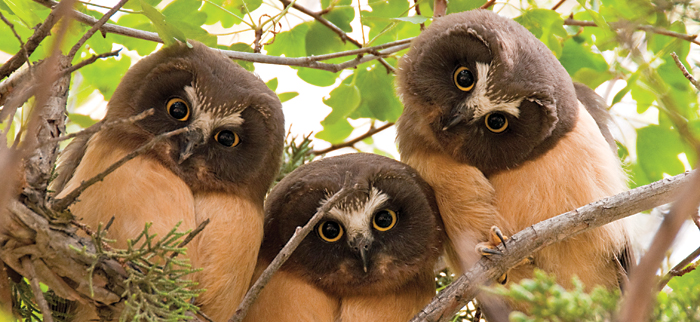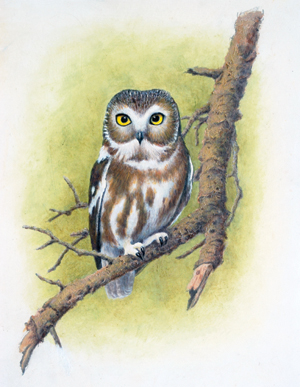The Secret Saw-Whet: Hiding in plain sight

Juvenile saw-whet owls; by Sam May
The northern saw-whet owl disappears simply by not moving. Flapping its wings would give it away. So, it remains motionless—a behavior developed through the ages—rather than fleeing from danger, using its neutral colors and physiology as natural camouflage.
While relatively rare in Maryland, they are common but seldom-observed birds found across North America, from southern Alaska through the central provinces of Canada to the Atlantic Coast and south in the Appalachians to the Great Smoky Mountains. Yet it is only by chance that a practiced observer spots one.

Saw-whet painting; by John Taylor
A hooter’s home
The preferred nesting habitat of the saw-whet owl is heavy coniferous forest, usually where it is wet and swampy. During migration and in the winter, it may be found in deciduous woods, but retains a decided preference for evergreens and thick brushy tangles of vegetation.
Because of its preference for northern forest habitats, it breeds only in Western Maryland counties such as Garrett, using natural cavities or abandoned woodpecker holes. It does not build a nest, but lays its eggs in the chips or debris on the floor of the cavity.
The plumage of the young bird is quite different than that of its parents. It has unmarked cinnamon-orange breasts and chocolate brown on the head and neck. A white “V” decorates its forehead.
Roaming research
The saw-whet has a strong migratory instinct, which has been well documented across the northeast. In October and November, exceptionally large flights take place along the Great Lakes and in the Delaware Valley. In Maryland, the owls regularly winter in the forests of the Eastern Shore and on Assateague Island.
At concentration points, department staff and volunteers who are passionate about studying the migration of the owls have established banding stations. Here, the birds are fitted with numbered leg bands. Much can be learned about its habits and wanderings. Of special interest was the capture of a saw-whet owl, originally banded in California in 2008. It caused many to wonder, what prompted this tiny nomad to fly such a distance in the wrong direction? The answer hopefully lies in continued research.
| Founded in 1994, Project Owlnet started as an effort to link owl researchers in North America. It facilitates communication, cooperation and innovation among a rapidly growing network of hundreds of owl-migration researchers in the U.S. and abroad. The project was the brainchild of Maryland Department of Natural Resources Ecologist Dave Brinker. |
“When we started Project Owlnet 25 years ago, we had very little information on the saw-whet owl,” Maryland Natural Resource Ecologist Dave Brinker says. “We started with about ten banding stations and now have 125 stations across the country. Since our start in 1985, volunteers have banded more than 10,000 saw-whet owls in Maryland alone and 217,434 across the country.”
“A lot of people didn’t understand the impetus for the project—they didn’t realize the magnitude of the saw-whet population,” Brinker says. “We really surprised them. It has turned this little known owl that people seldom see into the most banded owl in North America.”
 Branding the bird
Branding the bird
The etymology of the word “saw-whet” has led to a tangle of confusing rhetoric. Ever since the days of famed ornithologist John James Audubon, reams have been written to explain how the call of the owl sounds like the whetting, or sharpening, of a saw.
The saw-whet owl may have been named for giving a call that sounds like a saw being sharpened on a whetting stone, but there is no consensus as to which of its several calls gave rise to the name. Many do not think the owl ever sounded anything like a saw being whetted. What this owl does sound like is a “toot.” The same note, monotonously repeated, all on the same pitch.
It was apparently Audubon who first used the name “saw-whet.” He did not name it as such, but noted in his Bird Biographies (1839) that in Massachusetts the bird is known as “saw-whet.” He then goes on to describe in detail the similarity of the owl’s call to the sharpening of a saw.
Now, after 150 years, a more plausible explanation for the name “saw-whet” has been advanced. It could be called the French Connection. In France and in the French parts of Canada, the word for owl is “la chouette.” An Anglicized pronunciation would certainly sound like “saw-whet.” Further, if one considers that many French Canadians use an “s” sound for the initial “ch,” the derivation becomes more likely.
It seems puzzling that Audubon, who is of French descent and who travelled much of Canada and New England, did not notice the use of the word “chouette” by the people there.
It is one of many mysteries surrounding this stealthy little owl.
Article by John Taylor—local artist and wildlife enthusiast.
Appears in Vol. 19, No. 1 of the Maryland Natural Resource magazine, winter 2016.


 1-888-373-7888
1-888-373-7888 233733
233733